#alligators
Text

A young American alligator (Alligator mississippiensis) rides on the back of its mother in Brazos Bend State Park, Texas, USA
by Rick Dunlap
#american alligator#alligators#crocodilians#reptiles#alligator mississippiensis#alligator#alligatoridae#crocodilia#reptilia#chordata#wildlife: texas#wildlife: usa#wildlife: north america
24K notes
·
View notes
Text
Fairy godmother cranes guide their confused gator godchild back into pond
27K notes
·
View notes
Photo

United States House of Representatives Apportioned based on alligator population
11K notes
·
View notes
Text

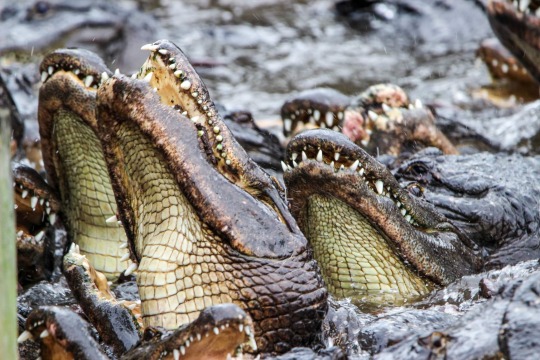
The fray 🐊
2K notes
·
View notes
Text
#WatercolorWednesday:

John Singer Sargent (American, 1856–1925)
Muddy Alligators, 1917
Watercolor over graphite on paper
H 34.3 cm (13.5 in) x W 52.1 cm (20.5 in)
Worcester Art Museum 1917.86
#animals in art#20th century art#1910s#impressionism#american imperialism#American art#john singer sargent#alligator#alligators#watercolor painting#painting#Watercolor Wednesday#Worcester Art Museum
2K notes
·
View notes
Text
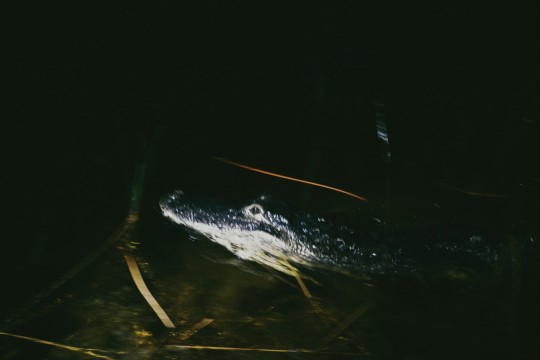
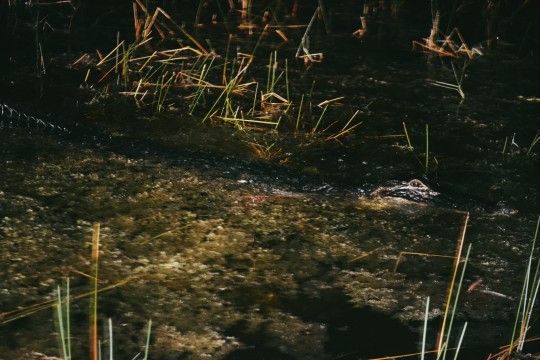

everglades
#mine#photography#original photography#rural#southern gothic#swamp#regional gothic#rural gothic#rural aesthetic#swamp gothic#alligators#animals#everglades#florida#florida gothic#swampcore#ruralcore#night#reptiles
1K notes
·
View notes
Text
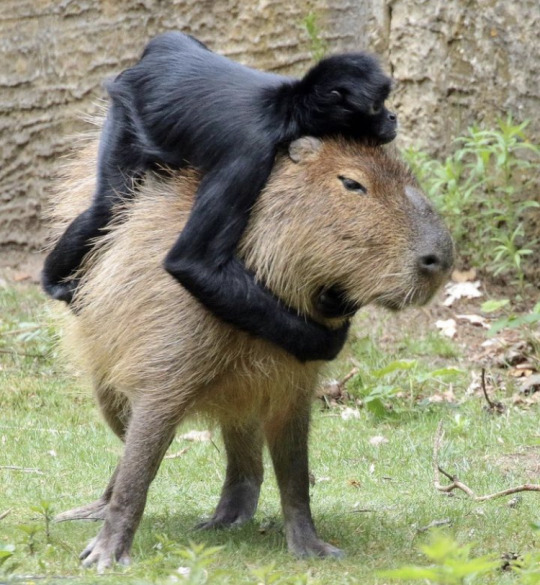

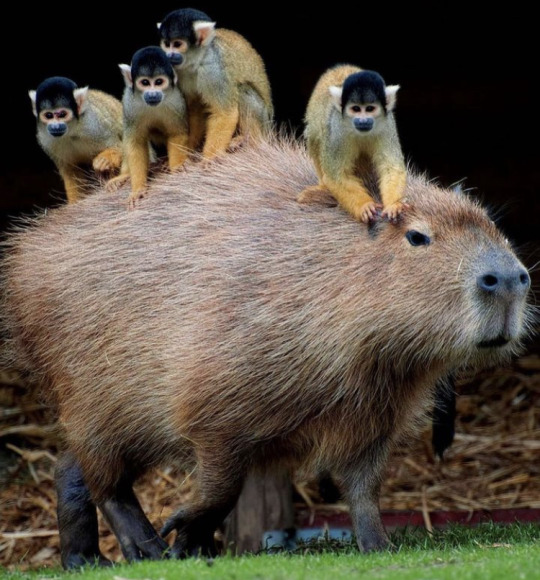



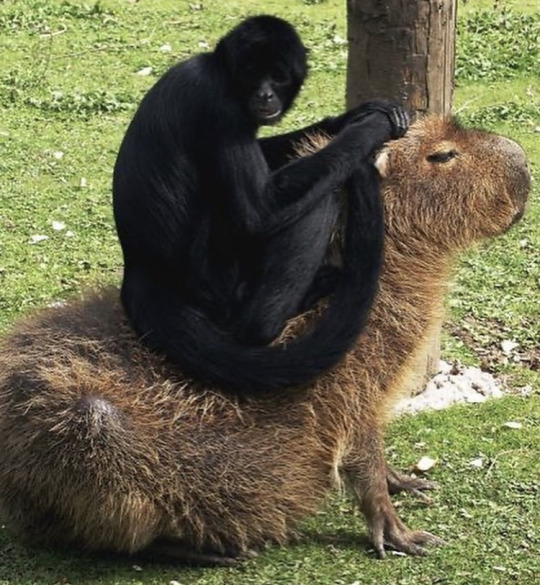

Capybaras and friends ♡
𝘊𝘢𝘱𝘺𝘣𝘢𝘳𝘢𝘴 𝘢𝘳𝘦 𝘴𝘰𝘤𝘪𝘢𝘭 𝘤𝘳𝘦𝘢𝘵𝘶𝘳𝘦𝘴 𝘵𝘩𝘢𝘵 𝘢𝘳𝘦 𝘴𝘰 𝘸𝘦𝘭𝘭 𝘭𝘪𝘬𝘦𝘥 𝘪𝘯 𝘵𝘩𝘦 𝘢𝘯𝘪𝘮𝘢𝘭 𝘬𝘪𝘯𝘨𝘥𝘰𝘮 𝘵𝘩𝘢𝘵 𝘪𝘵’𝘴 𝘯𝘰𝘵 𝘶𝘯𝘶𝘴𝘶𝘢𝘭 𝘵𝘰 𝘴𝘦𝘦 𝘵𝘩𝘦𝘮 𝘩𝘢𝘯𝘨𝘪𝘯𝘨 𝘰𝘶𝘳 𝘸𝘪𝘵𝘩 𝘰𝘵𝘩𝘦𝘳 𝘢𝘯𝘪𝘮𝘢𝘭𝘴
(via)
#cottagecore#nature#naturecore#capybara#this is so incredibly cute!!#wholesome to the tenth power#wild life#wild animals#apes#monkeys#ducks#alligators#birds
7K notes
·
View notes
Text
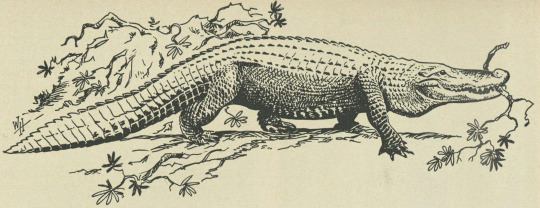
Florida Wildlife; vol. 12, no. 2. July, 1958. Illustration by Wallace Hughes.
Internet Archive
762 notes
·
View notes
Text
we're sleeping on how varied crocodilians are in colour and pattern
Yacare caiman

Tomistoma
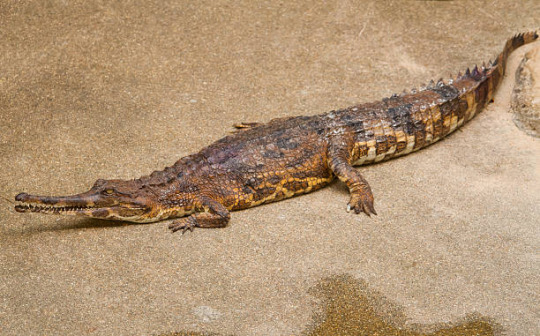
Cuban crocodile
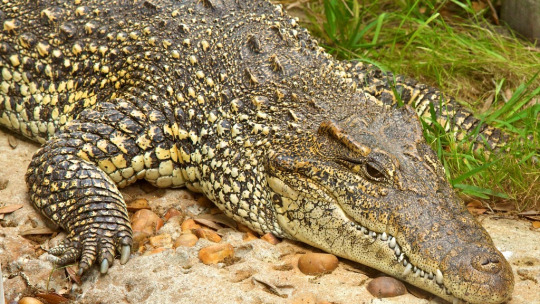
Cuvier's dwarf caiman

West African crocodile

American alligator
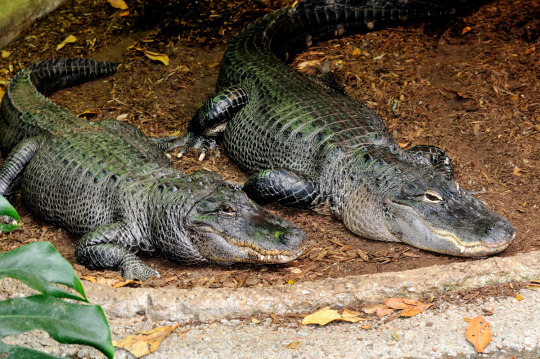
Saltwater crocodile

New Guinea crocodile
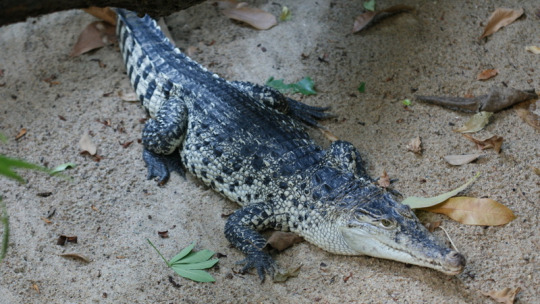
1K notes
·
View notes
Text
Happy Valentine's Day! When you think about love and the animal kingdom, are alligators an animal that comes to mind? No? Well, they should be, because they have some of the most interesting courtship behavior of any non-bird. (Bird displays are something else entirely.) I think it's time that you all are introduced to the Big Gay Alligator Sex Study, more properly known as Courtship Behavior of American Alligators (Alligator mississipiensis), written by Kent Vliet. You can get the paper at the link below!
This was a study done over a 3-year period in the 80s with a population of captive American alligators to look at how they interacted. Alligators are incredibly social and have complex behavioral dynamics, and their courtship rituals and routines are pretty dang interesting. In general, crocodilians spend a great deal of time interacting with each other when compared to other reptiles, and the courtship behavior of a few species is well-documented. But in this post, I'm mostly going to talk about the American alligator (with a quick detour into Cuban crocs).
Why Do We Care About Courtship?
So before I dive into talking about this study, let's talk about why we care about courtship (the social behavior that leads to mating) and mating (sexual interaction that could, hypothetically, lead to reproduction). Courtship and mating are extremely important when studying animal behavior- honestly, they're extremely important when studying zoology in general. In some cases, understanding this behavior actually a major conservation concern! For example, the Cuban crocodile is an endangered species. They're largely constricted to two swampy areas of Cuba, both of which also have American crocodiles present. And unfortunately, the female Cuban crocs find the male American crocs really, really sexy. This is a big problem, because with only about 3-4,000 Cuban crocs left in the wild (possibly even fewer), they need to be breeding with their own species to make more Cubanitos.

These. Make more of them.
But what scientists have found is that not only are there hybrid crocs in the wild, the Cuban population of American crocodiles is more closely related to Cuban crocodiles than other populations of American crocodiles, suggesting this has been going on for a very long time.
You can read more about that here if you want, but back to the gay alligators.
Alligator? More Like Alli-GAY-tor, amiright?
(actually that IS wrong it's more like alli-bisexual-tor, but that doesn't sound like alligator)

So how does a study like this happen? Back in the 80s, the American population was Feeling A Way about alligators. Something that you gotta understand when you're doing any kind of conservation is that people protect what they love, and they love what they understand. Alligators are a major conservation success story today- there's millions in the wild- but they were in serious danger of extinction in the 1960s, and it was a combination of legislation, awareness campaigns, and captive breeding at both zoological parks and commercial gator farms that helped bring them back. As a result, they were one of the first species to be de-listed from the ESA!
All of this attention meant that alligator science was flourishing in the late 70s and 80s, and that's where this study comes into being. This post is long enough so I'm not gonna go into all the details and methodology- you can find that in the paper I linked up top!
However, there is one piece of methodology we should talk about, and that's the choice of study population. It's part of what makes this particular study so interesting!. See, in a lot of cases, captive behavior really differs from wild behavior. This can be impacted by captivity conditions- what other animals the study animal has access to, what behaviors the animal has learned in captivity, even down to things like how the animals are fed. For example, some courtship behavior in captive animals can be the result of unnatural habitat conditions or limited social groupings. If you only have access to a couple of conspecifics, you don't have the same choices that you do if you have access to something closer to a wild population. If you've got a breeding group with one male and a handful of females, you can't ask or answer any questions about male/male interactions! Crowding is also an issue- too many animals in a space can be stressful, and lead to atypical sexual behavior.
But that's one of the cool elements of this study: the alligators in question live in a large social group in a lagoon that's basically just natural habitat with a boardwalk going around it. It's about as close to studying a wild population as you can get, with the advantage that it's far more accessible. And what this leads to is that that the researchers were able to see a really wide range of behavior, because all of the alligators had lots of access to lots of different mates. They were able to make choices that you wouldn't see in a smaller group. There's a trade-off that Vliet notes, and that is the population density and captive situation means that results might not quite work out the way they do in the wild- but in the years since, the results of the study have been vindicated with research into wild populations.
So, what are alligators into? Gay sex, group sex, yelling real loud, and lots and lots of... gentle caressing.
that's not a euphemism they spend a lot of time gently rubbing each others' faces
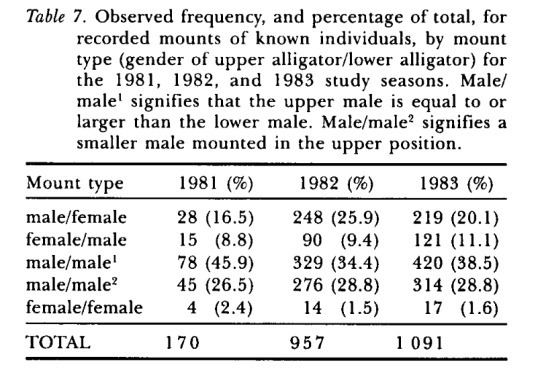
So first things first, it turns out that the vast majority of alligator mounting, which occurs after courtship behaviors like jaw rubbing, bellowing, head rubbing, and swimming together is male/male. Over the three year study period, an average of 68% of all sexual interactions were male/male. However, what they don't really notice is exclusivity, because when it comes to the sex of their sex partner, alligators... well. They aren't all that picky.
Another fascinating aspect of alligator courtship is what's called courtship groups. These are readily observed in captive settings (and in the wild, too, as mentioned in Dragon Songs), and are mixed-sex groups that spontaneously form. As other alligators approach a mounting pair, the original pair will happily split up and switch partners. Usually what happens is that the alligator on top slides off to initiate courtship with a newly-arrived individual. What's really interesting here is that, as the author notes, "males engaged in courtship with a female readily terminate that interaction and initiate interactions with males." Another fun element of alligator courtship is that while in most vertebrates, males approach females, alligator females often approach males. Usually it's the males approaching, but for many crocodilians, courtship initiation is an equal-opportunity affair.
Alligators are also really vocal during courtship! This is pretty unusual for a reptile- usually they're a quiet bunch. But crocodilians are pretty chatty. And during the breeding season, something pretty spectacular happens: infrasonic communication, better known as bellowing. This is sometimes called water dancing, due to the ripple patterns it makes. It's a loud, low-pitched rumble that conveys information about size and location, and is used for territorial displays and as a mating call. During the not-breeding season, a bellow means "stay away!" During the breeding season, it means "HOT ALLIGATOR SINGLES IN YOUR AREA."
Here's some pretty spectacular videos showing you what this looks and sounds like. The vibrations make the water above their backs splash up.
youtube
youtube
Alligators are also extremely tactile during courtship. The study has detailed analysis of touch in specific tactile zones along the head and neck of the alligators. Vliet notes "These sites have increased numbers of swollen pustular scale organs, the function of which is unknown."

What's kinda funny about this to me is that now, the functions of these organs are known- they're highly innervated tissues that help alligators detect prey in murky water. An alligator's jaws are more sensitive than a human fingertip due to the sheer number of nerve endings! So of course these areas are going to be highly sensitive, and to me it makes perfect sense that they feature so heavily in courtship.
So what can we take away from this 40-year-old study? Quite a bit! First, it's a great reminder that humans aren't special. We see same-sex mating behavior in pretty much every species we look at. We see it in cockroaches, spiders, and butterflies. We see it in sheep. We see it in alligators. We see it in every other species of great ape. Of course we also see it in humans! There's nothing that special about same-sex sexual behavior. It's a part of... pretty much everybody's evolutionary history.
Another thing I think is really important is that while this is an old study, it was absolutely pivotal as a turning point in helping people understand alligators. Remember how I said earlier that we protect what we love, and we love what we understand? This study showed the world that alligators weren't just mindless eating machines. They're socially complex! Understanding alligator sociality and how they choose mates and interact helped us care for them better. It told us more about how to keep them happy in captivity. Alligators are smart, communicative creatures. They don't always get along, but they don't always fight, either. (Don't get me wrong: they will fight each other, and they've actually evolved some pretty specific anti-other-alligator defenses... but they don't always fight, even during the breeding season.) This is interesting to me because in mammals, it's hypothesized that same-sex sexual behavior may have evolved for prosocial reasons; that is, it helps reduce conflicts. Perhaps it does the same for alligators.
In conclusion:
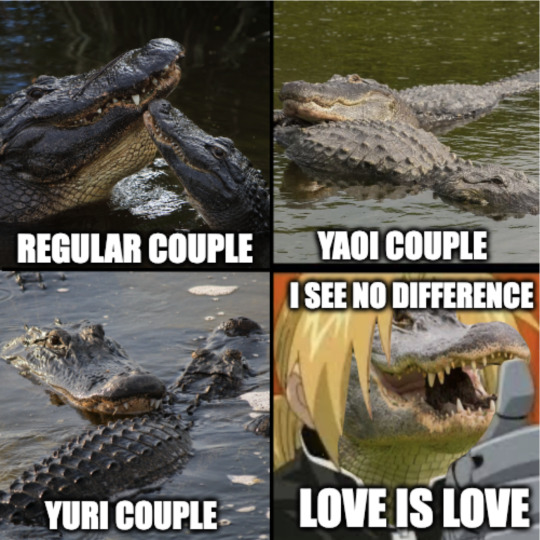
If you want to know more about alligator courtship and mating rituals, I can't recommend Vladimir Dinets's Dragon Songs: Love and Adventure Among Crocodiles, Alligators, and Other Dinosaur Relations highly enough. I know I talk about this book all the time, but it's easily the most accessible writing on crocodilian social behavior. It will change the way you think about and understand these animals.
Another phenomenal book is Alligators: The Illustrated Guide to Their Biology, Behavior, and Conservation by Kent Vliet. (Hm, wonder if he's written anything else...) This is basically the Bible for gator behavior. The photographs are absolutely gorgeous, too.
490 notes
·
View notes
Text

#Here are Three Simple Things You Can Do When Everything Starts to Slide to One Side#tips#tricks#life hacks#helpful hints#advice#unreality#alligator#alligators#but say it like Kermit the Frog does in THE MUPPET MOVIE when he’s talking to Dom DeLuise in the swamp
508 notes
·
View notes
Text
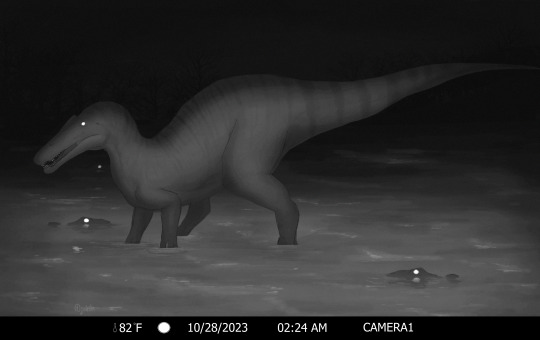
an anomaly in the everglades
#suchomimus#suchomimus tenerensis#spinosaurid#spinosaurids#spinosauridae#dinosaur#dinosaurs#theropod#theropods#theropoda#theropod dinosaur#paleontology#paleoart#paleoblr#prehistoric animals#alligators#my art#thinkin maybe t. rex next or something
591 notes
·
View notes
Photo

sun, moon, and monty stacking the daycare drums together
#art mine#2023 art mine#digital art#shapeshiftinterest#games#five nights at freddy's#fnaf#montgomery gator#monty#sun#sundrop#moon#moondrop#glittergolf#alligators#animals#robots#LGBTQA
2K notes
·
View notes
Text
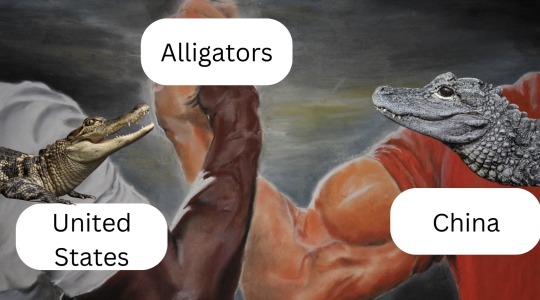
The global range map for the Alligator genus is funny
1K notes
·
View notes
Text
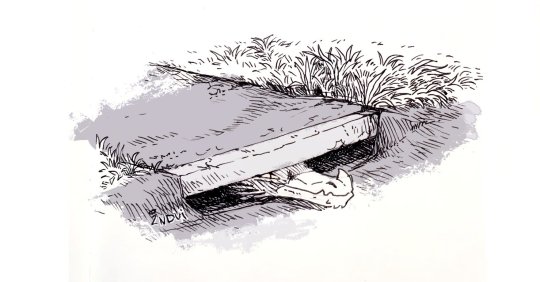
It's a little-known fact, but dragons actually lurk in the sunny, humid state of florida. They're just (understandably) usually mixed up with their alligator friends.
#alligator#dragon#xD#more old stuff...#i still laugh whenever i look at this...#boops the snoot#dragon art#florida#alligators#dragons#fantasy art#fantasy creatures#fantasy illustration#ink art
2K notes
·
View notes
